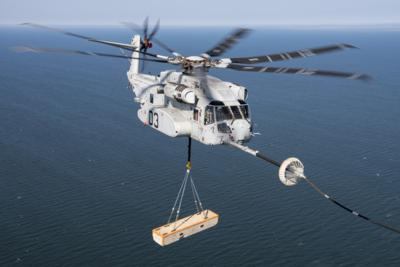It’s Good to be King—Finally
As Sikorsky gears up to commence full-rate production of its CH-53K King Stallion, the United States Marine Corps is making ready to train more of its units with the extraordinarily powerful new helicopter.

To date, the service has received seven CH-53Ks, with the acquisition program “progressing as expected”—according to Megan Wasel, spokeswoman for CH-53K acquisition program office.
The coming year will see the USMC’s rotary-wing fleet take on eight CH-53K King Stallions, with another 16 specimens to be added in 2024 and beyond.
Capable of carrying 27,000-pounds across a 110-nautical-mile combat range, the CH-53K King Stallion is three-times as powerful as its CH-53E Super Stallion predecessor. The King Stallion’s ability to move Light Armored Vehicles (LAV) across long stretches of sea is likely to prove an invaluable asset as the Chinese threat looms and the Pentagon turns its attention toward the islands of the Pacific.
In August 2022, the CH-53K deployed to the mountains of southwestern Idaho for its first training exercise. Staff Sergeant Dakota Schneider, a crew-chief instructor serving in Marine Aviation Weapons and Tactics Squadron 1, stated: “Routinely training with an LAV for an external load, to me, is absolute[ly] mind-boggling.” Of the CH-53K’s performance, Sgt. Schneider remarked: “It’s got power for days; you can do anything you want.”
The CH-53K King Stallion is an evolution of Sikorsky’s CH-53 family of helicopters—iterations of which have been in continuous service with branches of the U.S. military since 1966. The King Stallion features a trio of up-rated 7,500-shaft-horsepower (5,590 kilowatt) General Electric T408 turboshaft engines, a new elastomeric hub system known as HUMS, and composite rotor blades—the combined actions of which facilitate not only superb lifting power but dramatically improved high and hot performance. The CH-53K is the largest, heaviest, most powerful helicopter in the U.S. military—besting even the venerable CH-47 Chinook’s maximum gross take-off weight by a startling margin of 88,000-pounds to 50,000-pounds.
In addition to its formidable powertrain, the CH-53K sports an improved external cargo handling system, survivability enhancements, and design nuances intended to extend the model’s service life. The King Stallion’s 30-foot (length) by 9-foot (width) by 6.5-foot (height) cabin is 15% larger than that of the Super Stallion and accommodates two 463L master pallets—thereby eliminating the need to break pallets apart between airlifter (C-130, C-17, C-5) and helicopter.

King Stallion pilots will enjoy availing themselves of the machine’s digital glass cockpit and fly-by-wire controls with haptic feedback—the latter term pertains to technologies capable of mimicking aircraft feel by imparting forces, vibrations, or motions to pilots via aircraft control interfaces, e.g. yoke, cyclic, or rudder/antitorque pedals.
Notwithstanding its grunt and glorious pedigree, the CH-53K’s road to operability has been a long one. Originally ordered by the U.S. Marine Corps in 2008, the first King Stallion wasn’t delivered until 2018—with the goal of having it functioning in the USMC fleet by the end of the following year.
Regrettably, ground and flight testing brought to light more than one-hundred mechanical issues peculiar to the CH-53K. Principal among these was the tendency of the machine’s engines’ to ingest their own exhaust, overheat and stall.
In September 2020, Sikorsky—the Lockheed Martin subsidiary by which the King Stallion is manufactured—set forth that it had resolved nearly all of the helicopter’s mechanical shortcomings.
In September 2021, Marine Operational Test and Evaluation Squadron 1 used the inaugural King Stallion to recover a U.S. Navy helicopter stuck in California’s White Mountains. The CH-53K was the only aircraft capable of lifting the downed Navy chopper’s 15,200-pound bulk.
Finally, on 22 April 2022, Deputy Commander for Aviation Lieutenant General Mark R. Wise declared the CH-53K operationally capable.
 ANN's Daily Aero-Linx (05.02.24)
ANN's Daily Aero-Linx (05.02.24) ANN's Daily Aero-Term (05.02.24): Touchdown Zone Lighting
ANN's Daily Aero-Term (05.02.24): Touchdown Zone Lighting Aero-News: Quote of the Day (05.02.24)
Aero-News: Quote of the Day (05.02.24) ANN FAQ: Contributing To Aero-TV
ANN FAQ: Contributing To Aero-TV NTSB Final Report: Cirrus Design Corp SR20
NTSB Final Report: Cirrus Design Corp SR20




